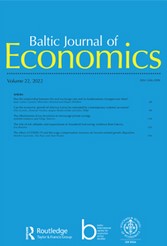What drove the rise in bank lending rates in Lithuania during the low-rate era?
What drove the rise in bank lending rates in Lithuania during the low-rate era?
Author(s): Jaunius Karmelavičius, Ieva Mikaliūnaitė-Jouvanceau, Andrius ButeikisSubject(s): Business Economy / Management, Micro-Economics, Economic history, Economic policy, Present Times (2010 - today), Fiscal Politics / Budgeting
Published by: BICEPS/SSE Riga
Keywords: Interest rates; loan pricing; banking; concentration; capital requirements;
Summary/Abstract: While Euro area interest rates were responding to accommodative monetary policy and decreasing throughout 2015-2019, in stark contrast, Lithuania’s bank lending rates increased. Although the rates dropped slightly around the onset of the pandemic, they are still elevated and well above the EA figures. This paper asks the question: what were the drivers of such interest rate dynamics in Lithuania? By analysing the historical events and practical aspects of loan pricing in Lithuania’s banking industry, we build an empirical model that exploits lending rate variation across banks, time and lending segments, and maps it to different drivers of pricing. We find that the recent changes in lending rates can be attributed to average bank margins, which moved largely in response to changes in market concentration.
Journal: Baltic Journal of Economics
- Issue Year: 23/2023
- Issue No: 2
- Page Range: 162-199
- Page Count: 38
- Language: English

